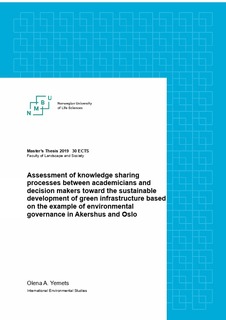| dc.description.abstract | It has been a rapid growth of interest to the potential benefits of green infrastructure in the environmental governance along with the balancing densification and greening processes for the sustainable development. In that case an efficient interplay between science and policy, “coproduction of science and policy”, becomes enormously important. Therefore, aim of this thesis is to gain a deeper understanding of the current level of science–policy interface, especially in the area of knowledge management processes that surround the both groups of actors.
Data for the mixed analysis was collected by using semi-structured face to face interviews from 63 participants who were involved into environmental governance in Akershus and Oslo. Analyzed units were separated into the two major groups. The Theory of Planned Behavior (TPB) was used to explore the behavioral response of actors towards the knowledge management processes.
Qualitative data analysis showed that groups of actors have as convergence or divergence points that can directly influence on their mismatch or similarity in interests close cooperation in the areas on environmental area. In particular, finding indicated that stumbling blocks of knowledge sharing among the decision maker’s group were associated with knowledge networking, lack or insufficient amount of knowledge, problem with knowledge source selection and knowledge use, effectiveness of knowledge transferring into policy, and communication barrier. While, among the academician’s group revealed knowledge networking barriers, effectiveness of knowledge sharing, political interference into process, motivation and willingness barriers, and lack of understanding policy process. Quantitative analysis showed a direct and indirect significant positive associations of the behavioral actor's Intention with the several variables that describe the knowledge sharing processes of the actors, along with an extended model variables.
Findings, that revealed challenges and capacity gaps in relationships between scientists and decision-makers and can be the serious constrains toward the sustainable development of environment in the area, gave the possibilities to make conclusions and propose the future recommendations for the sustainable development of environment in the area. | nb_NO |

